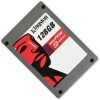- Qualcomm Launches Snapdragon 4 Gen 2 Mobile Platform
- AMD Launches Ryzen PRO 7000 Series Mobile & Desktop Platform
- Intel Launches Sleek Single-Slot Arc Pro A60 Workstation Graphics Card
- NVIDIA Announces Latest Ada Lovelace Additions: GeForce RTX 4060 Ti & RTX 4060
- Maxon Redshift With AMD Radeon GPU Rendering Support Now Available
Kingston SSDNow V+ Series 128GB

A couple of weeks ago, Kingston announced a revision to its V+ series of SSDNow drives. In addition to a brand-new controller from Toshiba being utilized, along with Toshiba NAND, the new V+ drives support TRIM right out of the box. This, along with good pricing and excellent performance, make the latest V+ drives well-worth looking out for.
Page 8 – Real-World: Windows Experience, Boot Times, Game Level Loading
Windows Experience
This is a test that any Windows 7 user can perform on their own system without needing to download anything. For those curious, Vista should allow the same, but we can’t guarantee the results will be directly comparable due to changes made in the WinSAT program. To run the program, hit the Windows Key + R at the same time, and type cmd into the run box. In the command prompt window type (or right-click and paste) the following without quotes: “cd c:windowssystem32” and hit enter. Once there input, again without quotes: “winsat disk -drive c -ran -write -count 10” and enter again.
This command runs a small portion of the Windows Experience Index’s drive assessment, specifically it uses small random writes and calculates how fast in MB/s the drive can sustain it. As we mentioned before with the HD Tune results, regardless of what drive is in question, its actual performance depends on what file size is being referred to. The smaller the file size, generally the lower the performance for a hard disk drive. So again, the small random file writes will be brutal.

That said the Kingston SSDNow V+ series completely walks away with this test and shows what a real SSD can do by almost reaching its rated write speed of 180MB/s! This is partially how this drive managed to fare so well in our Batch File tests.
Boot Time
For the boot test, we perform a cold boot, with the stopwatch starting the moment the power button is pressed until the last systray icon has finished loading. A large number of factors can change how fast a computer boots, from motherboard to just the BIOS configuration, so these times should not be used as an expectation of how fast the SSD will boot in your respective system. With some newer motherboards condensing the time taken in the boot process, boot times could reach significantly lower than these.

Once again, Kingston’s V+ SSD shines, coming out on top for our cold boot times.
Game Level Loading
Last, but certainly not least, are the game level-loading times. SSDs tend to improve application load times significantly over their mechanical brethren, and games are no exception.
Crysis is still infamous for how well it could stress the entire PC, and although Crysis Warhead was a significant improvement and more optimized than it’s predecessor, it still makes for one of the better gaming benchmarks to use. For this test, we timed how long it took to load the first level, Ambush. We also figured we would use the newer Left 4 Dead 2 game, for its slightly longer-than-average load times. Here, we timed how long it took to load the final chapter in the Hard Rain campaign.
While the difference between the best SSD and the typical HDD almost exactly halves the game loading time, is a difference of 15 seconds really worth it in L4D2, or difference of 30 seconds worth it in Crysis Warhead? Perhaps when you consider that each load time as you progress through the levels, with each stutter or “break” in the game to load new areas or new levels is also halved, and that it significantly improves the game immersion due to fewer and shorter game interruptions, then for some people the answer becomes a definite yes.

Here it appears Intel’s optimization of their drives for small random file operations instead of sequential writes pays off as the X25 is still able to retain a lead in Crysis load times. For L4D2 the Toshiba does edge out a marginal lead, although this game appears to not be bottlenecked by any sort of SSD, only hard drives.
Support our efforts! With ad revenue at an all-time low for written websites, we're relying more than ever on reader support to help us continue putting so much effort into this type of content. You can support us by becoming a Patron, or by using our Amazon shopping affiliate links listed through our articles. Thanks for your support!




